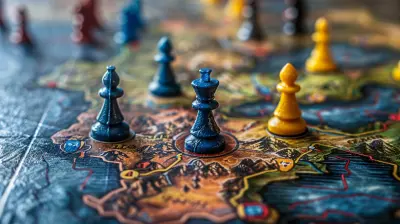18 April 2025
When you think about JRPGs (Japanese Role-Playing Games), chances are the first things that come to mind are epic battles, sprawling stories filled with drama, and fantastical worlds teeming with magic. That’s all well and good, but let’s be honest—sometimes you don’t want to save the world or fight an evil god. Sometimes, all you want is a quiet life, growing crops, casting your fishing line into a tranquil river, and maybe hunting for some wild mushrooms in the forest.
Sound familiar? You’re not alone. More and more JRPGs are embracing these chill, life simulation mechanics as a way to give players a break from all the monster-slaying and treasure-hunting. Farming, fishing, and foraging aren’t just side attractions anymore—they’ve become an integral part of what makes some JRPGs so memorable. Let’s take a stroll (instead of a sprint) through this cozy corner of the JRPG world and uncover why these life-sim mechanics are so beloved. 
Why Are Life-Sim Mechanics in JRPGs So Addictive?
Ever find yourself glued to a game because you just have to harvest those pumpkins before winter comes? That’s the magic of life-sim elements in JRPGs. They scratch this oddly satisfying itch in the human brain—the one that craves order, routine, and progress.It’s not just about doing chores either! These mechanics offer a surprising sense of achievement. You start with a barren patch of land or an empty fish bucket, and by the time you’ve finished, you’re basically a one-person farming empire or a fishing legend. Isn’t that what we all secretly want—a chance to build something from scratch?
And let’s not forget how relaxing it is. After a tough boss fight or an emotionally intense plot twist, plowing fields or catching fish acts as the perfect breather. It’s the gaming equivalent of wrapping yourself in a cozy blanket on a rainy day. 
Farming: Growing Crops and Building Communities
There’s something universally appealing about planting seeds, watering them daily, and watching them grow into something useful. It’s simple, sure, but it’s oh-so-rewarding. Farming in JRPGs isn’t just about raising crops, though—it’s often tied to deeper game mechanics like crafting, cooking, or even storytelling.Take Rune Factory for example, a franchise often nicknamed "a fantasy Harvest Moon." Sure, you’re out slaying some monsters, but when you come home, you’re tending to your fields, raising livestock, and whipping up meals. Farming in these games ties into almost every other mechanic. Want to survive that next dungeon crawl? Better grow those healing herbs.
And it’s not just about you, either—farming in these games often connects you to the NPCs (Non-Playable Characters) around you. Trade your crops for goods or gifts, and suddenly you’re making friends or wooing a potential in-game spouse. Before you know it, you’re not just managing a farm—you’re building a tight-knit community.
In games like Stardew Valley or Harvestella, your crops aren’t just tools for survival—they’ll help you form bonds with the world around you. Farming becomes a form of storytelling, and honestly? It’s kind of heartwarming. 
Fishing: The Ultimate Chill Mechanic
If farming is all about patience and planning, fishing is the king of “waiting for a bite”—literally. And that’s not a bad thing. Fishing in JRPGs gives you a reason to slow down and take in the game’s world. That picturesque lake with rippling water or the serene ocean view? Yeah, it’s not just for show; it’s an invitation to stop rushing and simply exist in the moment.Who hasn’t spent hours fishing in Final Fantasy XV, with Noctis geeking out over every catch? In fact, many JRPGs make fishing feel like its own mini-game or even a meditative ritual. You’re not just chucking your line and hoping for the best—there’s an art to it. Timing, equipment, and location all play a part in what ends up on your hook.
Fishing also has this magical quality of making you feel like an explorer. You’re not just trying to reel in some random fish—no, you’re hunting for the rare, elusive ones. Whether it's the legendary fish in Legend of Zelda: Link's Awakening or the special seafood recipes in Ni No Kuni II, fishing often rewards your persistence with rare treasures. And let’s be honest—don’t you feel like a legend after catching that giant, one-of-a-kind fish? 
Foraging: Hunting for Nature’s Bounty
Foraging is like treasure hunting, except instead of gold and jewels, you’re collecting mushrooms, herbs, and fruits. Sounds mundane? Think again. Foraging taps into this primal instinct people have to explore their surroundings and gather resources—it’s like being in a nature documentary but with fewer bugs.In games like Atelier Ryza or Ys VIII: Lacrimosa of Dana, foraging isn’t just a nice side activity; it’s essential. Those herbs you picked? They’re the key ingredient in a potion you'll need for your next big battle. Those flowers? Perfect for crafting that rare gear upgrade.
The beauty of foraging in JRPGs is how it rewards curiosity. See that sparkling patch of grass over there? Go check it out—you might find something rare. It’s like the game is giving you a constant nudge to explore every nook and cranny, feeding into that sense of adventure we all crave.
How Life-Sim Mechanics Balance the JRPG Grind
JRPGs are notorious for their grind. Whether it's leveling up your party or farming endless materials for gear, the grind can be… well, exhausting. That’s where farming, fishing, and foraging come in—they break up the monotony.Instead of repeating the same battles over and over, you get to do something completely different but equally fulfilling. These mechanics feel like a reward in themselves instead of a chore, offering you a peaceful retreat from the game’s more intense moments.
Mixing Genres: The Sweet Spot for Modern JRPGs
What’s fascinating is how these life-sim elements blur the lines between genres. JRPGs aren’t just about turn-based battles or epic plots anymore—they’re becoming hybrids of adventure, resource management, and even dating sims.Games like Harvestella or Sakuna: Of Rice and Ruin are prime examples of this blend. They take the core elements of traditional JRPGs but layer in farming, fishing, and foraging to create something unique. It’s no longer just about saving the world; it’s about living in it.
And really—isn’t that what makes these games so special? They’re not just about rushing through a story or powering up your character. They encourage you to slow down, take your time, and savor the small joys along the way.
Why We Love the Life-Sim Side of JRPGs
The beauty of farming, fishing, and foraging in JRPGs lies in their simplicity. These mechanics remind us that not every moment in a game needs to be filled with high stakes or adrenaline-pumping action. Sometimes, the moments spent planting seeds, reeling in a fish, or gathering herbs are the ones we cherish the most.In a way, these life-sim mechanics make JRPGs feel more human. They ground the fantastical worlds we explore and make them feel lived-in and real. It’s like finding little pockets of peace in an otherwise chaotic adventure.
So, the next time you’re wandering through your favorite JRPG and stumble upon a fishing spot or a patch of fertile soil—take a moment. Cast your line. Plant those seeds. Who knows? You might just fall in love with the quiet side of the game.



Andrew McKale
Great article! I love how you highlighted the balance of life simulation within JRPGs. Well done!
April 19, 2025 at 4:03 PM